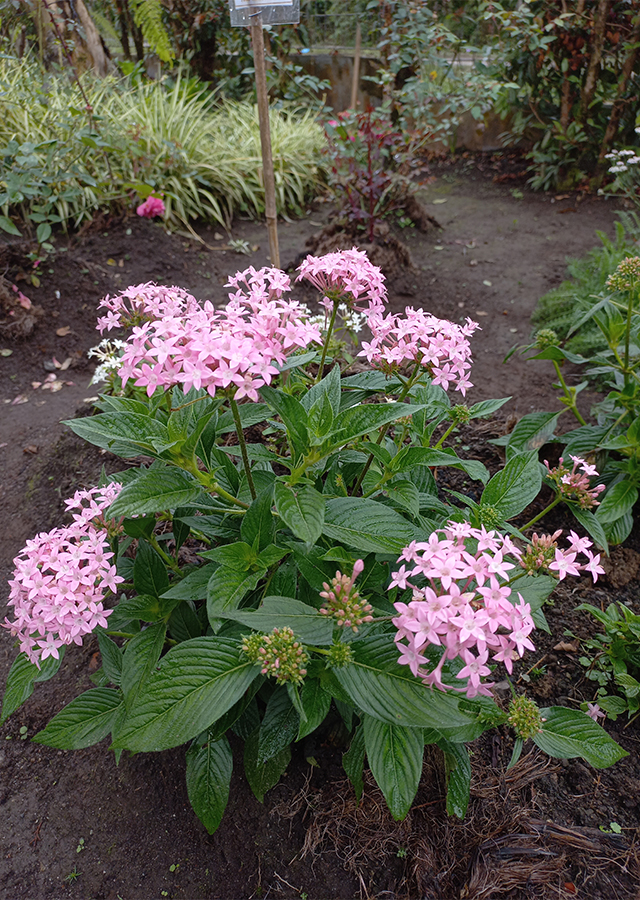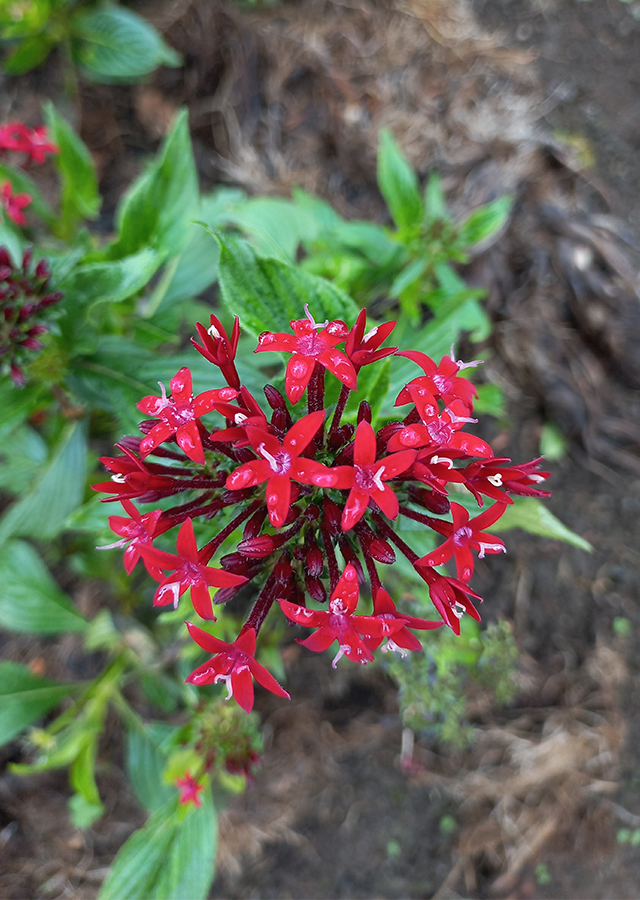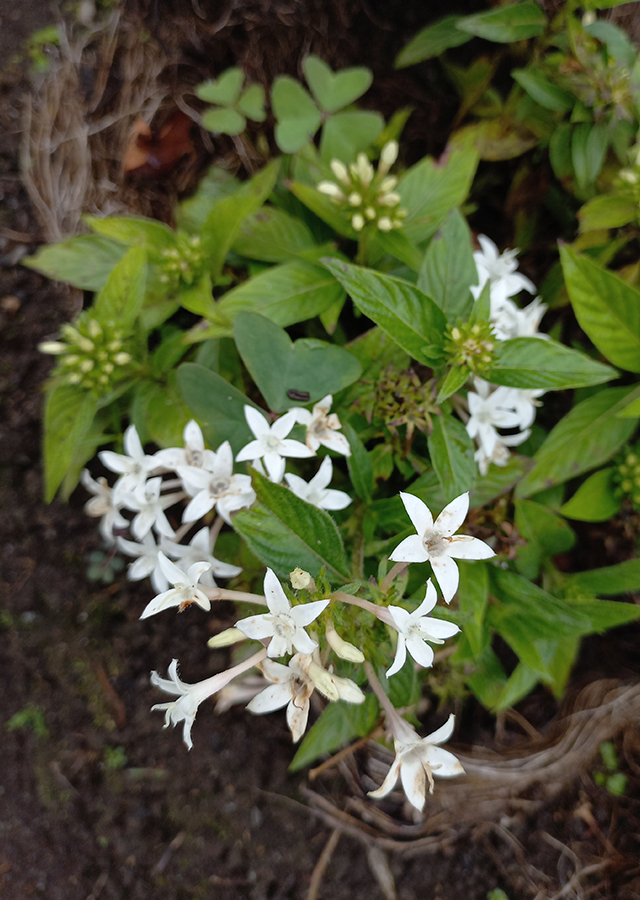Egyptian Starcluster
Pentas lanceolata (Forssk.) Deflers
Rubiaceae
Location in our garden
Principal



Synonym
Manettia lanceolata (Forssk.) Vahl
Mussaenda aegyptiaca Poir.
Mussaenda lanceolata (Forssk.) Spreng.
Habitus
Shrubs. A fast growing perennial shrub that grows 30-70 cm tall.
Part Used
Leaves
Flowers
Roots
Growing Requirements
Full Sunshine
Need Shade
Habitat
Forest
Roadside
Shrublands
Grassland
Overview
Pentas lanceolata is native to East Africa and the Arabian Peninsula. Its native distribution range extends from Ethiopia to Mozambique, Yemen and Saudi Arabia. It has been introduced as an ornamental and potted plant worldwide and can now be found naturalized all over the tropics and subtropics. It is commonly cultivated as an ornamental in gardens, parks and yards. It is also used in traditional African medicine.
Vernacular Names
Estrellita de jardin (Spanish), Wu xing hua (Chinese), Sinu (Fiji), lluvia de estrellas (Dominican Republic).
Agroecology
Pentas lanceolata grows in woodlands, forest margins, scrublands, rocky hillsides, and grasslands at elevations from sea level to 2.500 m. It occurs as a common weed along roadsides, and on abandoned farms and disturbed sites near villages. Grows best in warm and moist habitats with a mean annual temperature of 27 °C. Although this species tolerates a wide range of soil types and textures, it prefers well-drained soil with pH 6,1 to 8,5. It thrives in full sun but can also tolerate partial shaded conditions. It is also adapted to grow in water-stressed environments such as dry thickets and semiarid habitats.
Morphology
- Stem - branches quadrangular, moderately to densely pilosulous to villous often becoming glabrescent with age.
- Leaves - opposite, petiole 0.5-3 cm, pilosulous to villous; blade drying papery, oblong-lanceolate to ovate, 5-14 × 2-5.5 cm, adaxially scabrous or villous to glabrescent, abaxially densely villous or hirtellous at least along principal veins, base cuneate to obtuse, apex acute or shortly acuminate; secondary veins 8-10 pairs; stipules truncate to broadly rounded, 1.5-2 mm, villous, bristles 1-5, 1-4 mm.
- Flower - inflorescence densely pilosulous to villous; peduncle 3-12 mm; branched portion congested-cymose often becoming lax, 1.5-4 × 1.5-4 cm; bracts narrowly triangular to linear, 0.5-1.5 mm. Flowers sessile or subsessile, distylous, lobes narrowly oblanceolate to elliptic or narrowly spatulate, 2-8 mm, usually unequal on an individual flower with nearly this entire size range found on some flowers, acute. Corolla pale purple to pink, red, white, or yellow, salverform, sparsely hirtellous to glabrescent outside; tube slender except rather abruptly swollen in throat in long-styled form (around stamens), 17-20 mm, densely barbate in throat; lobes elliptic or oblong-lanceolate, 3-4 mm, acute to obtuse.
- Fruit - capsules obovoid, 4-6 × 4-6 mm, stiffly papery to woody, with beak 1-2 mm tall.
- Seeds - 0.5-1 mm.
Cultivation
- Generative propagation is by seed - seeds germinate 5-12 days after sowing when outdoor daily temperatures are about 22 °C. Under favourable environmental conditions, plants will bloom 15-19 weeks after sowing.
- Vegetative propagation is by stem cutting.
Chemical Constituents
Quinones, iridoid glucosides, coumarin, anthraquinones, terpenoid, flavonoids, saponin glycosides, alkaloids.
Traditional Medicinal Uses
- Parts of plants are used as a remedy for tapeworm, itchy rashes, pimples, malaria, skin diseases, gonorrhoea, syphilis and as a purgative.
- It is used in the treatment of abdominal cramp, meningitis, boil, lymphadenitis.
- The extracts of the flowers are useful for wound healing.
Part Used
Reference Sources
- CAB International. (2021). Pentas lanceolata (Egyptian starcluster). https://www.cabi.org/isc/datasheet/120131. 15-01-2022.
- Giday, M., Asfaw, Z., Woldu, Z., and Teklehaymanot, T. (2009). Medicinal plant knowledge of the Bench ethnic group of Ethiopia: an ethnobotanical investigation. Journal of Ethnobiology and Ethnomedicine. doi:10.1186/1746-4269-5-34.
- Kew Royal Botanic Gardens. (2017). Plants of the World Online: Pentas lanceolata (Forssk.) Deflers. http://powo.science.kew.org/taxon/urn:lsid:ipni.org:names:760275-1. 15-01-2022.
- National Park of Singapore. (2021), Flora Fauna Web: Pentas lanceolata. https://www.nparks.gov.sg/florafaunaweb/flora/3/2/3232. 15-01-2022.
- Schripsema, Jan, et al.(2007). Iridoids from Pentas lanceolata. Journal of Natural Products 70(9):1495-8. DOI:10.1021/np070116+.


